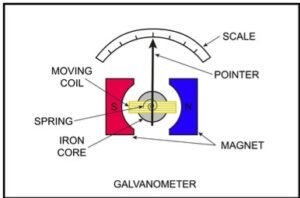Moving Coil galvanometer

A moving coil galvanometer is a key instrument for measuring and detecting small electric currents in physics experiments, working by translating electric current into pointer deflection through magnetic forces .
Construction
A moving coil galvanometer typically features a lightweight rectangular coil of copper wire, suspended between the poles of a strong horseshoe magnet . The coil’s plane is kept parallel to radial magnetic field lines using concave pole pieces, ensuring accurate and linear readings. Inside the coil, a soft iron core intensifies the magnetic field, while a spring or fine wire provides both support and a restoring force .
Working Principle
Current flowing through the coil creates a magnetic torque, turning the coil. The pointer attached to the coil moves over a scale, and the restoring force from the suspension wire keeps the system balanced. The deflection θ obeys:
NBIA
where N is number of turns, B is field strength, I is current, A is coil area, and k is torsional constant . Since deflection is proportional to current, the instrument is both sensitive and reliable.
Applications
-
Measuring and detecting low currents in circuits
-
Used in modified forms as ammeters (with low resistance shunt) and voltmeters (with high resistance in series)





